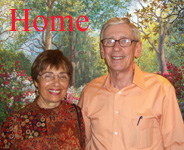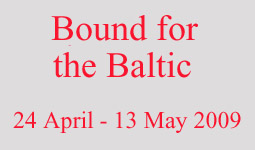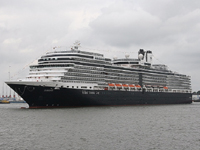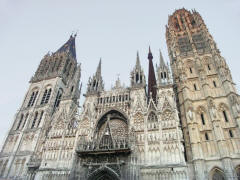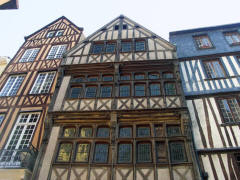Page 1 2 3 4 5 6 7 8 9 10 11 12 Friday, 8 May. This was another day at sea. The weather was cool (high of 53) and partly cloudy with a strong breeze and large swells. The Bay of Biscayne is known for rough weather, so this was pretty mild. We enjoyed a leisurely day. I went to the gym in mid-afternoon . The gym was forward on the top (11th) deck where the ship's motion was the most extreme. That made it difficult both to run on the treadmill and to lift weights. I stepped on the digital scale in the gym and, instead of my normal weight of 148 pounds, the dial seesawed from 162 to 132 as ship went up and down. At 9:00 we went to a performance by Jacqueline Roche, a talented British singer. Saturday, 9 May. The ship docked in Le Havre at 7:00 a.m. The weather was cool but pleasant (high 61). It was mostly sunny during our tour. We had signed up for the bus tour to Rouen, the capital of Normandy. Normandy, of course, was named for the Normans (Northmen) as the local population called the Vikings. Beginning about 795, Vikings landed on the coast and repeatedly traveled up the river Seine to Paris, pillaging everything in their path. France was then made up of many rival feudal landowners who wouldn't unite to fight the common enemy. Rouen, along with the other cities on the Seine, was repeatedly sacked. Finally, in 911 King Charles III negotiated a treaty with Rollo, the Viking leader, giving him Rouen and the surrounding area in exchange for Rollo's protection from future invasions. Thus the Duchy of Normandy was created with Rouen as its capital. Our bus left at 8:30 for the 75 minute drive up the Seine to Rouen. Our guide first took us on a one hour walking tour, then we had an hour on our own. The guide began our tour in the Place du Vieux-March' (Old Market Square) where Joan of Arc was burned at the stake (1431) and where the modern Ste.-Jeanne d'Arc Church (1979) now stands. Inside, the church seemed to have somewhat of a Scandinavian look (Dansk?), perhaps intentional in view of Normandy's history.
Then we walked down Rue du Gros-Horloge (Street of the Large Clock), the main pedestrian street, toward the Place de la Cath'drale a few blocks away. The street passes through an arch below the Large Clock (dating to 1528). This old clock only has one hand (close enough in the 16th century), but also gives the phases of the moon and has various other displays.
Then we arrived in Cathedral Square. Notre Dame Cathedral (consecrated 1063, mostly rebuilt in the 13th century, completed in the 17th century) is one of the most beautiful examples of French Gothic architecture. Claude Monet painted many pictures of this cathedral. As is the case with many fine cathedrals, though, the square in front of it is too narrow to fully allow a grand view. Some of the original medieval stained glass windows have survived, including some featuring the famous cobalt blue of that period. Among the most famous tombs here is one containing the heart of Richard the Lionheart. As we exited the cathedral through the south trancept, we passed by the magnificent 15th century Escalier de la Librairie (Booksellers' Stairway).
Our guide then led us down some of the narrowest streets of the
old town. Until the practice was banned in the early 16th century, the upper
floors of many houses projected out beyond the floor below. The city fathers
concluded that this cut off the fresh air and contributed to the plague that
wracked the city. In one place we stopped, the
lane was no more than five feet wide to begin with, but the overhanging upper
floors on either side completely blocked the sky.
The guide led us back to the tourist office near the Cathedral and turned us loose. We walked into the very old section behind the Cathedral, past the Church of St. Maclou (a smallish parish church begun in 1434), and up the picturesque Rue Damiette to the Church of St. Ouen (originally built in the 14th century as the abbey church of Saint Ouen Abbey). We couldn't go inside, though, because our time was running out and we still had to make a rest stop on the way back to the bus. Once again on the bus, we started the drive back to Le Havre. We'd brought a light snack with us so we didn't mind that it was 1:30 by the time we got to the ship. We had lunch and took it easy the rest of the day. The ship sailed at 9:00 p.m., an hour late because several of the tour buses were delayed by traffic. We went to the screening of Benjamin Button at 10:00. It lasted two hours, 40 minutes. Fortunately we were gaining an hour during the night, so it wasn't too bad. | ||||||||||||||
